Writing about Cossack culinary traditions can be a challenge as there is already a lot of information available, especially about the traditions of the Cossack authorities or the Zaporizhizhian Sich. However, there are still interesting details that can help us enhance our understanding and form a more comprehensive view of the Christmas and New Year traditions of Ukrainian ancestors.
It’s worth noting that the traditional winter holiday cycle used to last from November 15 (Philip’s, also known as Christmas Fast) to January 6 (Feast of Epiphany). Christmas Eve and Christmas were important to the clergy, students, townspeople, and commoners for various reasons. However, for the Cossacks, though they respected Jesus, the New Year’s beginning was more significant from a practical standpoint. This was due to several specific reasons.
During the Hetmanate era, winter holidays such as Christmas or New Year were not considered significant days off. Based on the dates mentioned in Ukrainian Hetman’s proclamations or letters, it can be inferred that many orders were issued on the eve of holidays, and it was just a routine matter. Moreover, holiday greetings were often written after presenting the more important matters, making it evident that the festive celebrations were not the main priority. Often, gifts sent for the holidays were not always delivered on time.
During the holiday season, Ukrainian Hetmans, in compliance with their vassal obligations, had to ensure that they greeted their political patrons and neighbours, particularly the Moscow Czars. Some of the surviving documents dated 17th-18th centuries contain traces of this tradition. For instance, the letters of Ukrainian Hetman Ivan Mazepa dating from January to February 1688 show that Christmas presents were sent to the monarchs, including Ivan, Peter, and Sophia Alekseyevna of Russia. In return, the hetman was given various allowances, Rhine wine, lemons, fresh fish, pickles, and even vinegar. In that same year, Mazepa sent deer and two wild boars to Vasily Golitsyn, who was the favourite of the tsar, asking him to “accept the gifts graciously and eat them for good health”. In 1704, the Hetman sent a part of the ‘life-giving’ cross to Fyodor Golovin, one of Peter I’s associates, as a Christmas gift. He received sincere thanks for this gesture in a letter dated December 24th. In that same month, Mazepa sent greetings to Alexander Menshikov, Peter the Great’s favourite at the time, likely not anticipating Alexander’s plans to take over the Hetmanate and seize all of the Hetmanate’s wealth. During the reign of Ukrainian Hetmans, it was customary for them to send timely greetings to the monarchs. Meanwhile, representatives of the Cossack authorities would rush to the Hetmanate’s capital (which could be Chyhyryn, Hadiach, Baturyn, or Hlukhiv, depending on the historical period) to congratulate the hetman and his family. Other notable figures, such as church hierarchs, city officials, foreign diplomats, and even travellers, also made their way to the capital to offer their congratulations. Members of the elite would come accompanied by their families and servants, bringing along precious clothing, tableware, and gifts for the hetman, their godparents, and relatives.
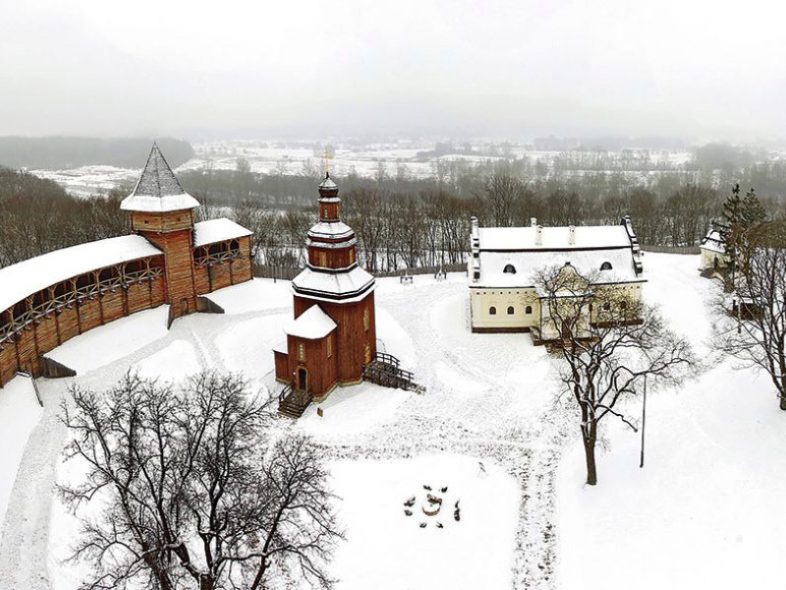
Baturyn, once the Cossack capital, today.
On December 24, while the hetman retained a certain degree of autonomy and could write letters and issue administrative orders, members of the General Council, colonels, higher church hierarchs and other well-wishers were already rushing to his courtyard with presents. They would bring delicacies and exotic items to try and impress the head of the Hetmanate. Some of the gifts included black caviar, the meat of wild animals, rare birds, oranges, citrons, foreign wines, confections like candied fruits, watches, expensive tableware, valuable weapons, silk belts, and scarves. After receiving greetings from officials of the General Military Chancellery, clergy, and professors from the Kyiv-Mohyla Collegium and listening to eloquent and sophisticated wishes, everyone proceeded to the churches for a solemn liturgy.
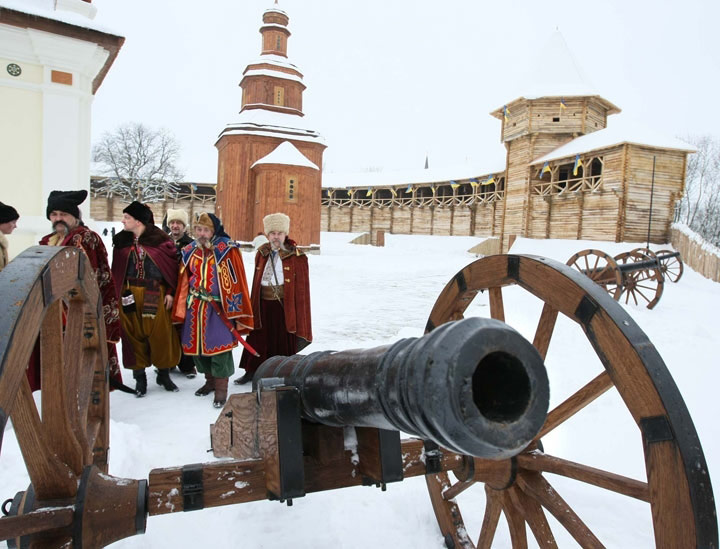
Once the festive service was over and the symbolic first star appeared in the sky at the hetman’s residence, a banquet would commence.
The celebrations were extravagant in every sense of the word. During Mazepa’s reign, his residence had the capacity to host up to 200 people. The tables for the guests were draped with silk or linen tablecloths and decorated with metal, glass, and porcelain tableware. The silver spoons, forks, and knives were set on the tables in a meticulous manner. The invited guests were keen observers of the latest fashion trends in the Hetman’s court, which they later imitated.
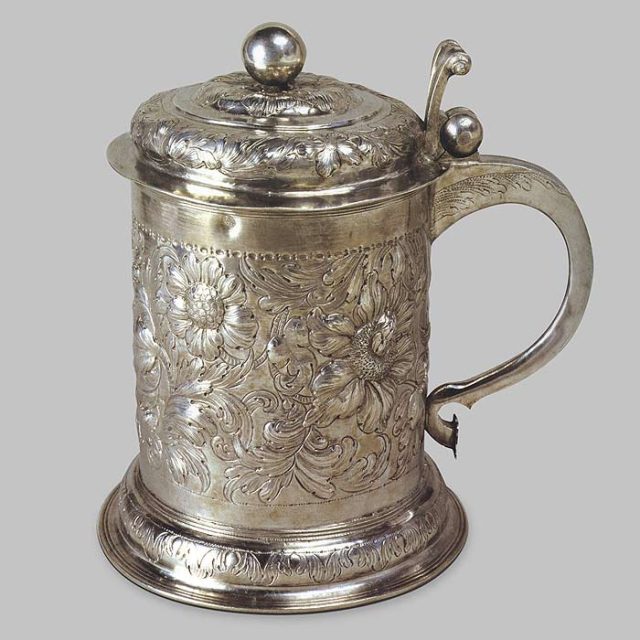
Hetman Ivan Mazepa’s drinking vessel, 18 century.
After the Christmas fast, the guests indulged in dishes and spirits. Interestingly, the hetmans were primarily served by the local cooks. For instance, on a trip to Moscow in 1702, the hetman was accompanied by 11 Ukrainian cooks, and in 1703, there were 7. Ivan Skoropadsky brought 6 cooks to St. Petersburg in 1718, all of whom were Ukrainians. However, foreign cooks were also employed occasionally. For instance, the court of the last Ukrainian hetman, Kyrylo Rozumovsky, was famous for its French cooks. Hetman Ivan Mazepa even “lent” a German cook named Jagan to Peter I in 1702.
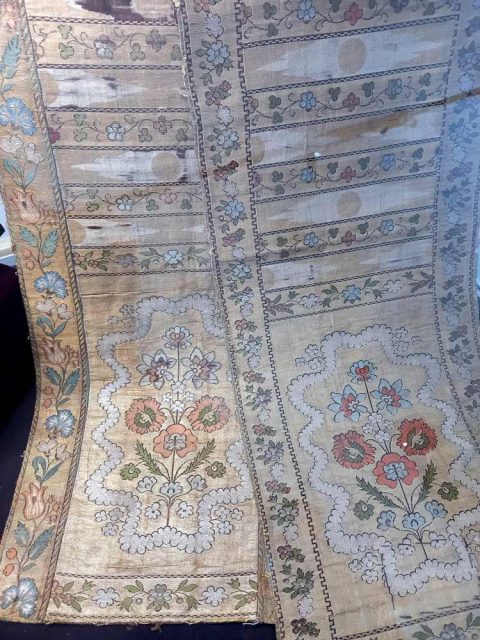
Silk Cossack Belt, 18 century.
It is fascinating to discover how hetmans used to entertain their guests. It’s said that Bohdan Khmelnytsky was skilled at playing either the lute or the kobza. A German traveller named Hildenbrandt visited the hetman’s residence in Chyhyryn and confirmed that “The hetman called for a zither to be brought to him, played a few notes, and then returned it.” Ivan Mazepa was also a talented musician and dancer, and he played the bandura exceptionally well, indicating his background and upbringing at the royal court.
Mazepa had his own musical group that performed at the Hetman’s palace in Hontcharivka for the guests. Some of the musicians in the ensemble were sent to him by the Duchess Anna Dolska. Mazepa not only had a political alliance with her but also a romantic relationship.
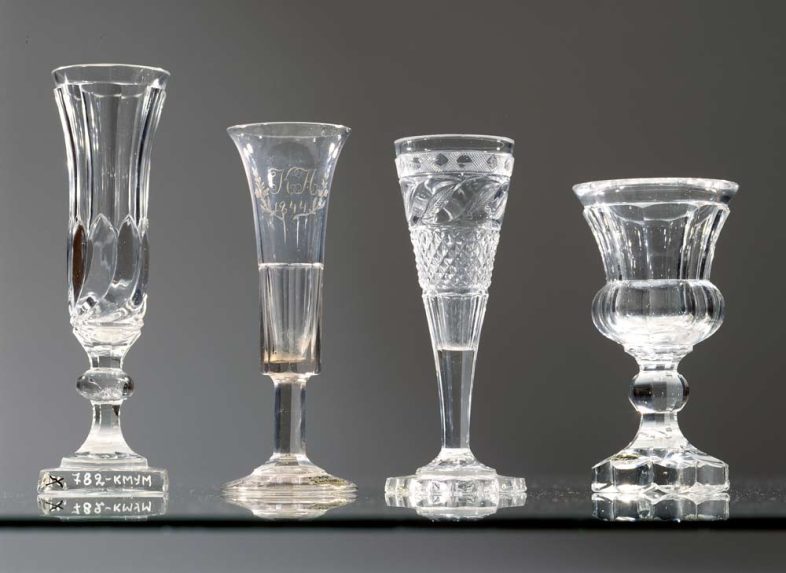
Cossack glasses, 17-18 century.
During the feast, Ivan Mazepa often pretended to doze off when he noticed that members of the General Council, colonels, and other guests were getting drunk. However, he would actually listen attentively to what his elders were saying to stay informed about the political sentiments of his surroundings. Theatrical performances, balls, and performances by Italian opera singers were often organised in the palace of Hetman Kyrylo Rozumovsky in Hlukhiv. The famous “horn” orchestra, led by Czech conductor Karel Lau, played for them. After the Hetmanate was dissolved, this unique musical ensemble was sold to Prince Grigory Potemkin.
During the Christmas holidays, nativity scenes (Vertep) were often performed at the Hetman’s and the Cossacks elders’ courts.
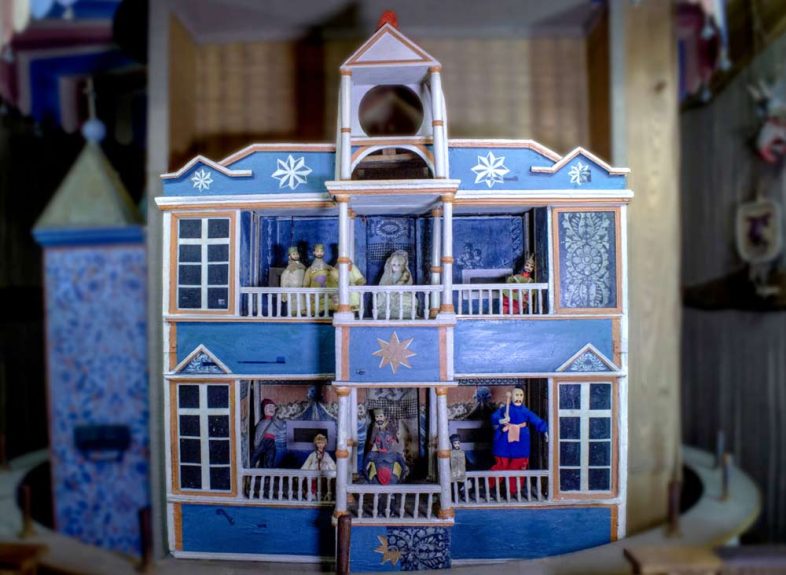
Vertep, Nativity Scene, 18 century.
Throughout the 18th century, fireworks became a fashionable innovation during Christmas and New Year celebrations. The General Military Artillery was in charge of preparing this spectacle. To please the hetman and his guests, pyrotechnics experts often created firework displays using powder candles and igniters. They would shape them into wreaths that bore the initials of the Hetman, monarchs, or esteemed guests. Unfortunately, casualties resulting from carelessness were not uncommon, as sometimes, the entire annual supply of gunpowder was used during the festivities.
Winter festivities in exile
Interestingly, Christmas and New Year celebrations were observed with great liveliness and festivity not only in the Hetmanate capitals but also in exile. We know about Pylyp Orlyk’s family’s holiday celebrations thanks to fragmentary records in his travel diary. After leaving Sweden in 1720, the hetman and his family moved to the Polish-Lithuanian Commonwealth. On January 17, 1721, Orlyk, accompanied by his son Hryhoriy-Petro, arrived in Wrocław. On that day, he “enjoyed good health” and the “happy reunion with the family,” doing nothing but resting in the family circle. A few days later, Orlyk noted in his diary that his daughter Anastasiya-Teodora “attended a costume ball”. On January 24, Orlyk wrote again: “Today Nastusya [Anastasiya] was at a costume ball wearing a mask”. In early February, Orlyk met with his younger daughters Varvara (Basia) and Marta-Anna (Martusia), who at the time lived together with their mother in the Ursuline monastery. Orlyk recorded that they enjoyed themselves riding through the city in a sleigh. Young girls and boys participated in these activities. Afterwards, the youth went to a ball, where they “danced until late at night”. It is worth noting that during their time in Europe, Cossack elites, as well as their wives and daughters, were really fond of wearing fashionable clothing and following contemporary European fashion. This included wigs and high-heeled shoes.
Celebrations on the Sich
The way Christmas and New Year were celebrated on the Sich was different from how it was celebrated in the territory of Hetmanate. The festivities were considerably more modest. According to Dmytro Yavornytsky’s famous work “History of the Zaporozhian Cossacks”, on Christmas Eve, the Cossacks consumed solomakha (rye flour thickly boiled with water), teteria (rye flour or buckwheat not very thickly boiled on kvass), shcherba (thinly boiled flour on fish broth), and bratka (wheat porridge with additives). As the first star appeared, delicacies were added to the table, such as wildfowl, fish, dumplings, cheese pancakes, buckwheat dumplings with garlic, “pig’s head with horseradish and noodles”, brynza cheese, pastirma (sun-dried mutton), and zagreby (cakes piled up with ashes and baked on hot coal). Among the drinks on the table were horilka, drinking honey, beer, braga, and numerous infusions.
To add to the festive atmosphere, the Zaporizhzhians played various musical instruments such as banduras, violins, bagpipes, lyres, basses, cymbals, kozas, sopilkas and whistles.
Dancing was also a part of the celebration, although it was less refined than Hetman’s receptions. In the late 16th century, Bartosz Paprocki, a Polish chronicler, described the Cossack dance as an “inexpressible art”. However, in 1652, in a letter to Margrave Friedrich Wilhelm of Brandenburg, an anonymous correspondent described the Cossack movements as looking similar to “animals in a swamp”. The Cossacks also enjoyed playing cards and dice. The festivities would end with a traditional fireworks display in the form of loud gunfire from cannons.
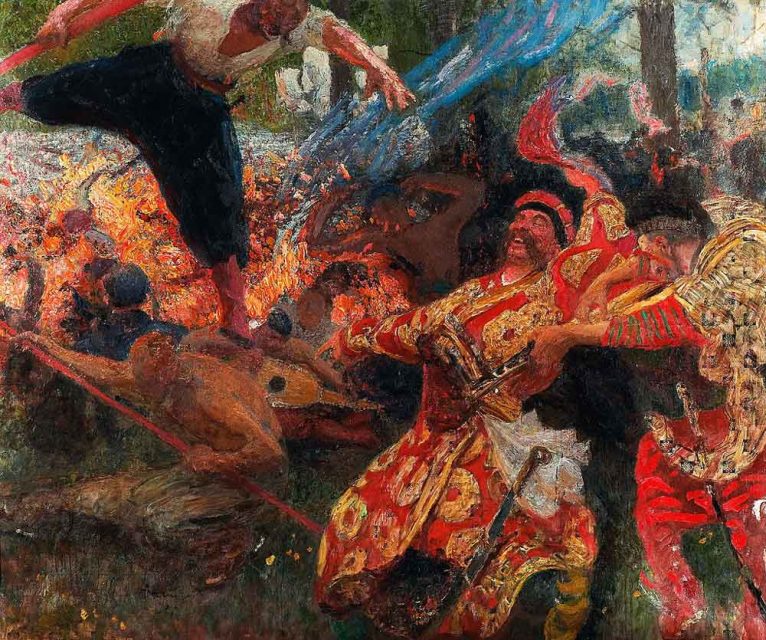
Ilya Repin, Hopak, 1927.
For the Zaporizhzhians, Christmas celebrations were not as significant as the Cossack Council held on January 1 to mark the Saint Basil’s day. On the same day, a council was also traditionally held in the Hetmanate’s capital. On the eve of the council, conflicts and brawls sometimes erupted because land redistribution and seniority re-elections were coming up. At the General Council, new personnel appointments were discussed, tax policies were debated, and preparations for military campaigns were made. Thus, the Cossack council on January 1 effectively initiated an order that remained unchanged throughout the year, ensuring the community’s stability.
The hetmans and the Zaporozhians didn’t always have warm relations, but they exchanged Christmas greetings. A unique greeting sent out by Hetman Ivan Mazepa in December 1693 has been preserved. In his letter, Mazepa addressed “his friends and brothers; atamans, as well as the elders and juniors, of the Army of the Zaporozhian Sich”. Ivan Mazepa wished “all the good fellows of the Lower Sich good health and joyful behaviour during the festive days”. He also promised to reward them well and hoped that “the Good Lord blesses them all with every happiness”. After the winter holidays, Mazepa promised to gift the Zaporozhians a new iconostasis for their recently built church and agreed to send craftsmen to install it. Once the Epiphany celebrations concluded on January 6, life returned to its usual cycle.
As we look back on the time of the Hetmanate, it becomes clear that the military and political elite of that era celebrated Christmas and New Year’s holidays in a manner similar to that of European royal courts. Even the Zaporozhian pursued special entertainment that differed from the customary rituals observed by the peasants. However, traditional elements such as the didukh (sheaf of wheat) and the 12 meatless dishes served on the festive table, which appeared in the 19th century, resulted from societal changes following Ukraine’s loss of statehood. Therefore, it is essential to acknowledge Ukrainian traditions from the 17th and 18th centuries and the partial revival of elements of those celebrations to maintain our identity and defend our sovereignty today.

